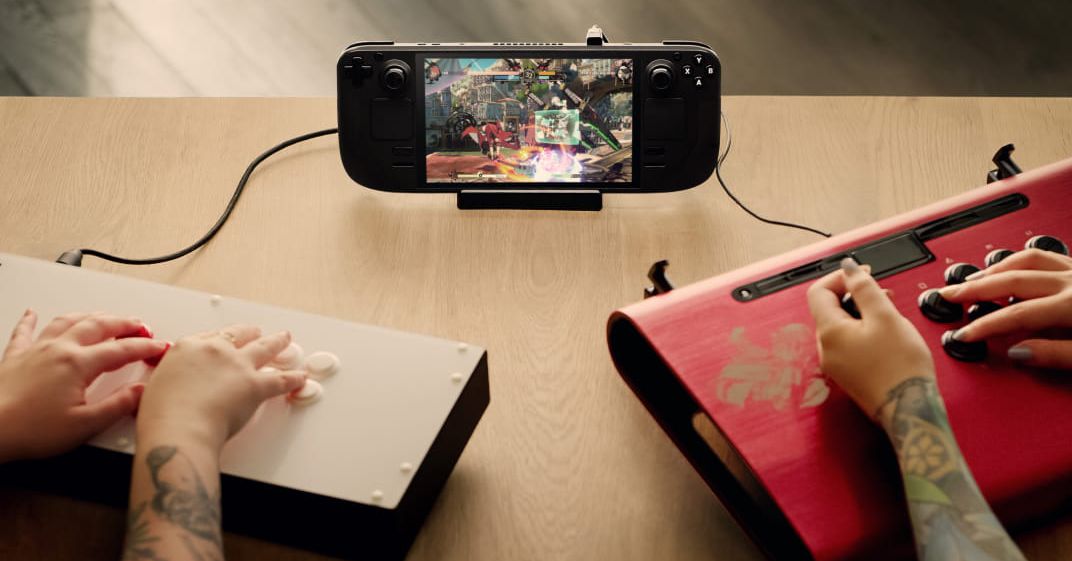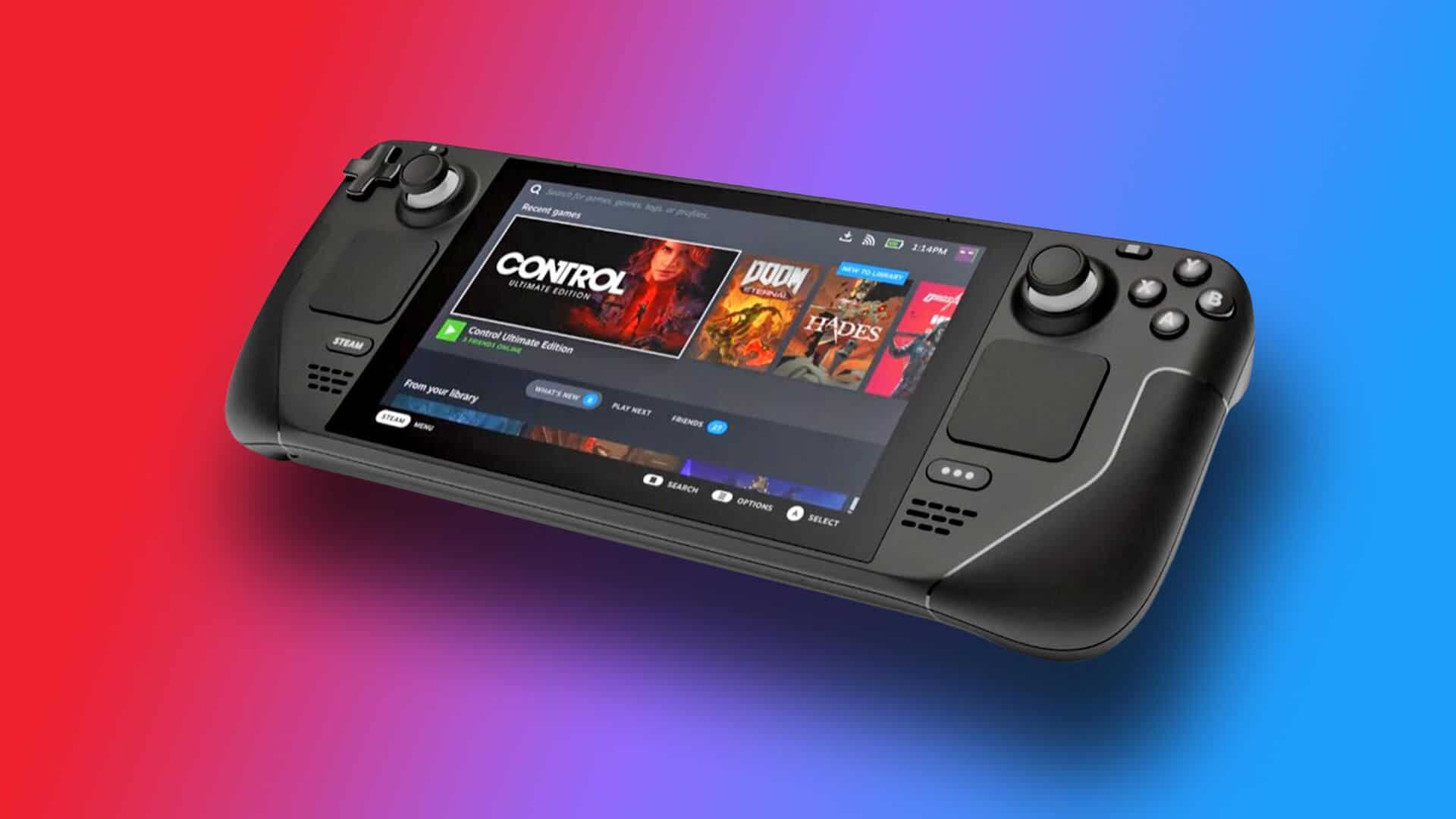As a lot of you know, I’m a huge fan of the Nintendo Switch. The very first commercial convinced me that this console would be Nintendo’s best one to date. I wasn’t wrong. I’ve spent countless hours on my Nintendo Switch and played a multitude of amazing games, but recently I found myself enjoying a different handheld a bit more. Enter the Steam Deck, a gaming handheld that isn’t limited by its hardware, this is a true next-gen handheld that’s capable of running the most modern games without a problem. Time to meet Nintendo’s biggest competition!
Hello big boy
The first thing you’ll notice when you unbox your brand-new handheld is its size, compared to the Switch, this is one huge handheld. With its 11.7 x 4.6 x 1.9 in (298 x 117 x 49mm), this handheld clearly isn’t designed for smaller hands. For me personally, it’s a breath of fresh air. If I play on my Nintendo Switch in handheld mode for a couple of hours, I’m often forced to stop my session due to some cramps, something that’s even worse on the Switch Lite. On Steam Deck, I never suffered from any cramps thanks to its bigger design and pleasant weight. The Steam Deck is almost double as heavy compared to the base Switch version but this never bothered me. It’s a solid big boy that easily fitted my hands and resulted in some casual gaming sessions.
The design itself isn’t that spectacular and feels more like a retro console, to be honest. It didn’t bother me a lot but if you’re looking for a slick handheld, the Steam Deck doesn’t check a lot of boxes. Valve clearly went for quality over aesthetics and thanks to the impressive control options, the company clearly succeeded in doing so. Everything about the Steam Deck just screams quality and power, clearly, this isn’t designed for children, Valve wanted to bring the power of gaming PCs to adult hands and after spending a couple of weeks with my Steam Deck, I can confirm that the size and weight are nothing to worry about.
True current generation gaming
I received my Steam Decks a couple of weeks ago, which gave me more than enough time to test a couple of games. From smaller indie games such as Vampire Survivors and Paint the Town Red to newly released heavy hitters like God of War and Final Fantasy VII Remake Intergrade, I tested them all and all were very pleasant to play. One of Steam Deck’s biggest advantages is its available control options. With Touch, dual trackpads with haptic feedback, buttons, triggers, and thumbstick, the Deck clearly has your favorite option on board. For those with a Steam Controller, the trackpads on the Deck offer the same computer mouse experience in the palm of your hands. I didn’t use them a lot but for the more tactical or tycoon game, it’s a real blessing to have those trackpads. The combination of the touch screen and the trackpads easily mimic the experience you would have on your PC while operating your game with a mouse and keyboard. Besides the impressive trackpads, the action buttons, triggers, and thumbstick are created with some of the best technology currently available. Like most consoles, the thumbstick is clickable, giving you an extra button to, for example, sprint in-game. A pleasant surprise is the extra triggers on the back. You can program those depending on which game you’re playing but let me tell you, those extra triggers are a true blessing in more complex games, especially deeper first-person shooters. Although the top triggers are correctly placed, it’s a bit easier to use the triggers on the back if it needs to go fast. Now that we got the design and controls covered, let’s move over to the screen and performance.
The screen is a solid 200×800 LCD screen that’s able to display the games in a big and bright way. It’s not as good or colorful as the Nintendo Switch’s OLED screen but it certainly does the trick. If you compare both screens, Nintendo’s OLED screen is the clear winner but that is something you’ll easily forget if you’re playing a game like God of War in 60 fps in the palm of your hands. There’s something unbelievable about being able to play such high-demanding games in handheld mode. The AMD APU with quad-core Zen 2 CPU, 8 compute-unit RDNA 2 GPU (4-15w), 6GB soldered LPDDR5 memory, and up to 512GB SSD storage, the Steam Deck is the most powerful handheld to date and nothing really compares to it. It feels like a portable Xbox Series X or PlayStation 5 and I’m pretty certain you’ll be blown away when you test some of the more demanding games currently on Deck. From Final Fantasy to Deathloop, and even Grand Theft Auto V, all of those games run impressively well on Deck, which made it painfully hard to go back to some of my Switch games. Don’t be mistaken by its clunky design, the Steam Deck clearly delivers when it comes to raw power and really is that portable gaming PC we’ve all been dreaming of.
Room for improvement
Generally speaking, I adore the Steam Deck, it’s everything I wanted and even exceeded my expectations. But, there is still room for improvement. The Steam Deck itself is still in a rather early phase, which means that not the entire Steam Library is playable. Most of the games are and it’s easy to see while scrolling through the story if a game is Steam Deck verified or not. If a game isn’t verified, it doesn’t mean you can’t play it on your Deck. Most of the time, it means you’ll have to tweak some of the control options or text size to make it playable but after spending some time with those options, you’re still able to enjoy the game on your Deck. There are a couple of games however that aren’t playable at all, Destiny 2 being one of the bigger games you’re missing out on. Valve is constantly testing and adding games to the Steam Deck verified section but as for today, keep in mind that not all games are playable just yet.
That being said, the battery life is the Steam Deck’s true Achilles heel. If you’re using it to play some Indie games, you won’t really notice the short battery life. In those smaller, less demanding games, you can easily use the Deck for up to eight hours straight, an entirely different situation compared to more demanding games. Want to play God of War on the highest settings and best frame rate? Sure, but your battery will be completely drained in less than two hours. This certainly is rather disappointing and although there are a couple of hours to prolong your battery life in those demanding games, it never really gives the result you’re hoping for. Of course, you can use external power banks to charge your Deck while playing but those take away from the system’s portability. If you’re using the Deck inside your home, it’s nothing to really worry about but if you’re traveling for a couple of hours, you better have a backup plan.
Conclusion:
The Steam Deck is a true powerhouse and plays games that no other handheld on the market can play. It’s an extremely impressive handheld device that brings the power of Steam to the palm of your hands. Its only major downside is its battery life but besides that, this truly is a next-generation handheld device.
8/10




